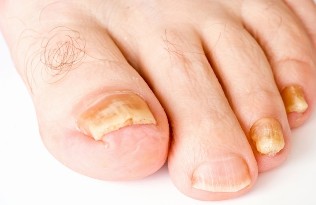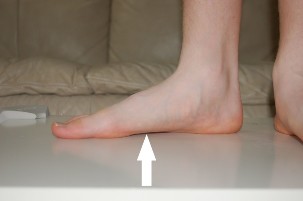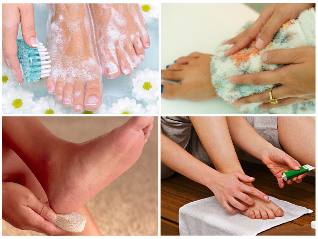Fungus of the nail plates on the feet is called onychomycosis. Initially, the infection affects the big toe, but as development spreads to others. The disease goes through several stages. The sooner treatment is started, the easier it is to cope with the problem. This is especially significant in relation to the nail of the thumb of the lower limb: a large bed, and the size, so the extent of damage is significant.

Stages of onychomycosis
Fungus of the nail plate goes through several stages of development, each of which is characterized by certain symptoms. There are such stages of the disease:
- Initial. At this stage, no visible pathological abnormalities were observed: the changes are external. The nail plate on the fingers of the lower limbs lose their luster. On the surface there are white spots or stripes. Overall, the nail looks healthy, the person does not feel pain or discomfort. If the identified onychomycosis at this stage, you can quickly get rid of it.
- Average, or progressive. Pathological changes already exposed the structure of the nail. Plate acquires a pronounced yellowish tint, foliated, and breaks. Also, there is an unpleasant smell coming from the affected foot.
- Neglected, or degenerative stage. There is a deep lesion of the nail. In this case, the infectious process proceeds with the thumb on the other. The entire surface of the nail plate affected by the fungus and exfoliate from bed, becomes loose. The patient was worried about severe itching. When pressure is applied on the affected areas causes pain and feeling of pulsation. Because of this, the patient can not wear closed shoes.
Stage dystrophic onychomycosis
In the third stage of infection possible infection of the skin of the feet. In this case, the cure is possible only with the combination therapy, which involves the use of local drugs and drugs for systemic effects (tablets for oral administration).
The reasons for the development of fungus on big toe

The main reasons which cause the development of onychomycosis are:
- contact with a person who is a carrier of a fungal infection;
- disregard for the rules of hygiene;
- wearing someone else's close or not appropriate for the size of the Shoe;
- a weakened immune system;
- a visit to the baths, saunas, swimming pools or beauty salons where they can not be used disinfected instruments;
- injuries of the nail and the skin that surround him.
- flat feet;
- prolonged use of antibacterial drugs;
- hyperhidrosis (excessive sweating in the feet);
- the presence of endocrine or immune lesions;
- a disruption in the circulatory system, which is especially important for elderly patients;
- varicose veins;
- diabetes.
Flat feet is one of the causes of onychomycosis
An important factor that increases the risk of developing onychomycosis is advanced age. Elderly people suffer from poor blood circulation to the extremities, which also increases the risk of fungal infections. The causative agent of the disease falls on the nails or skin with contaminated objects or through contact with a carrier. The pathogen spreads rapidly, occupying new areas. In the subungual space fungus enters through damaged areas of the nail plate or areas of the skin that surround it. The fungus spreads rapidly, heading to the nail bed. The speed of advancement exceeds the rate of growth of the plate. Soon, the pathogen succeeds and provokes changes in the structure of the nail. It is established that from the fungus 3 times more often affects men. Nail plate hit those types of fungi like dermatophytes, molds and yeast.

When to see a doctor?
Contact the doctor at the first signs of fungus. It is not necessary to wait until show obvious signs of the disease: the formation of white spots and even mild itching in the feet should be cause for treatment to a specialist mycologist or a dermatologist.
Diagnosis
To the diagnostic activities that will help to identify the disease and its stage, include:
- visual inspection of the nail plate;
- a fence of a tissue sample of the affected nail;
- culture – sow the seeds obtained from the patient material on culture medium to identify species of microorganisms that hit the nail.
In some cases, the specialist conducts a differential diagnosis and distinguished from the onychomycosis of diseases such as lichen planus, psoriasis, keratoderma.
Treatment of fungal infection in nail at an early stage of development
If the disease was detected at an early stage, dealing with it will be much easier. In this case, is usually sufficient application of means of the local nature that impact directly on the affected nail. The duration of treatment depends on the condition of the nail plate and may vary from two to four weeks. Any medications designed for treatment of even mild forms of mycosis of the nails, shall be appointed by the doctor.
Running therapy of onychomycosis
In severe fungus, and in the case of a running of the infectious process, illustrates comprehensive treatment. Be sure to prescribe antifungal agents for systemic effects, if there are no contraindications. Patient is prescribed drugs:

- Systemic antibiotic in pill form. The active ingredient of the drug reaches the site of localization of pathogenic microorganisms and has a fungicidal effect.
- The drug inhibits the development of germs and destroys them. The course of treatment and dosage determined by your doctor. Means adverse reactions.
- The drug has fungicidal effect. The active substance gradually accumulates in the layers of the nail plate that allows you to destroy even those fungi that are localized deep enough.
Also when running the nail fungus effective treatments that can get rid of the infected plate. This can be done in the following ways:
- The surgical removal. This method involves podawanie plate sharp surgical instrument and its tearing off from the bed. After surgery bandage. Traumatic and surgical method rarely used. Instead, the practice of minimally invasive methods.
- Removing the plate with chemicals that promote the rapid exfoliation of the affected nail. In this case the problem area is treated with a special solution , wait until the drug starts to work, and then employ the tools that help you quickly separate the plate from the nail bed.
- The laser treatment. It is a modern painless method that will allow you to quickly get rid of fungal nail. The laser light affects the plate, quickly heating it to high temperatures. The beam penetrates deeply and eliminates pathogenic microorganisms. The method is bloodless and completely safe, as it does not cause burns.
At the advanced stage of onychomycosis is necessary to follow exactly the doctor's recommendation, as the absence of adequate treatment increases the risk of generalized damage of the body the fungal infection.

Traditional methods
Treatment of nail fungus on the big toe can also be performed using the methods of folk medicine. Such methods are complementary and cannot be the basis of therapy. The most popular folk remedies include:
- The pulp of onions. To grind grated some onions and apply the resulting mass to the affected nails. Top fix bandage. Leave for 15-20 minutes, rinse.
- Hydrogen peroxide. The affected leg pre-hold in the bath with water to the nails maximally softened. After that remove the upper layer plates. A piece of gauze impregnated with hydrogen peroxide and wrap the finger with the affected nail, capturing directly the lesion. Leave for 40-50 minutes. Repeat the procedure up to two times a day.
- Apple cider vinegar. It is important to use a natural product. Take 2 tablespoons of vinegar and add the same amount of vodka and a tablespoon of glycerin. In the resulting composition, dip a cotton swab and apply to nails for 15 minutes. Repeat 4 times a day.
Folk recipes help to ease the severity of symptoms and eliminating discomfort, but they are not able to destroy the causative agent.
The disease and especially the treatment of nail fungus in children
In children onychomycosis is quite rare. The main reason for the disease is weak due to incomplete formation of the immune system. Symptoms of onychomycosis in children are:
- loss plates your natural pinkish color, the appearance of gray or white spots on the surface;
- the unevenness and roughness of the nail plates;
- crumbling and brittle nails;
- redness and swelling of the skin that surrounds the infected nail of the child.
For the treatment of nail fungus in children typically use only local use drugs. If necessary, appoint and system tools. The most safe for the child are capsules . Antifungal medicines for oral administration should be prescribed only by a doctor.
Peculiarities of treatment in pregnant and lactating
In pregnancy high risk of developing onychomycosis in that case, if earlier the woman had an illness and not completely cured him. This is due to the weakening of the immune system that occurs during pregnancy. It is important to cure the fungus, as in severe cases it creates a risk of secondary bacterial infection that threatens the health of both mother and fetus. Systemic medications during pregnancy cannot be used as they have a high level of toxicity. During pregnancy and lactation should include local medicines, but only those that are safe for the expectant mother and her child. These include the sulfur-salicylic ointment, ointment mikasalla.

Treatment in elderly
In the elderly decreased immunity – the natural age-related phenomenon, which creates additional risks for the development of onychomycosis. In this case also caution was exercised when selecting a treatment for fungus of the nail plate. Systemic medicines are prescribed if the illness lasts a year or more, and in the case of extensive lesions and dystrophic changes in the nails.
Prevention
If signs of fungus on the little finger or the thumb should immediately contact the doctor. But you can take steps that will prevent the development of this disease. Should follow these recommendations:
- wash your feet at least once a day;
- wash socks daily and wear clean;
- when sweating is to use a special deodorant for the feet;
- to wear shoes the right size, it should not be too close, also it should be washed daily;
- use only personal hygiene products and tools for manicure and pedicure;
- when you visit the pool, beach, sauna use personal rubber shoes;
- wash feet with soap after swimming, baths, if necessary, to use pharmaceutical means for prevention.
Fungus of the toenails is a disease that is quite difficult to cure at the stage of progression. At the first symptoms should consult a doctor. Treatment depends on the stage of development of onychomycosis: the initial enough drugs local action, while running the necessary systemic antifungal agents.
















